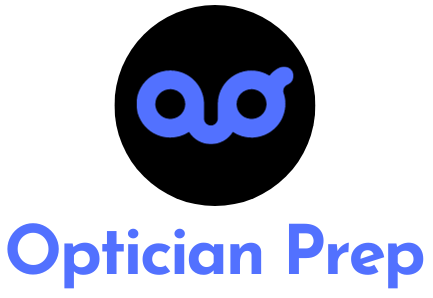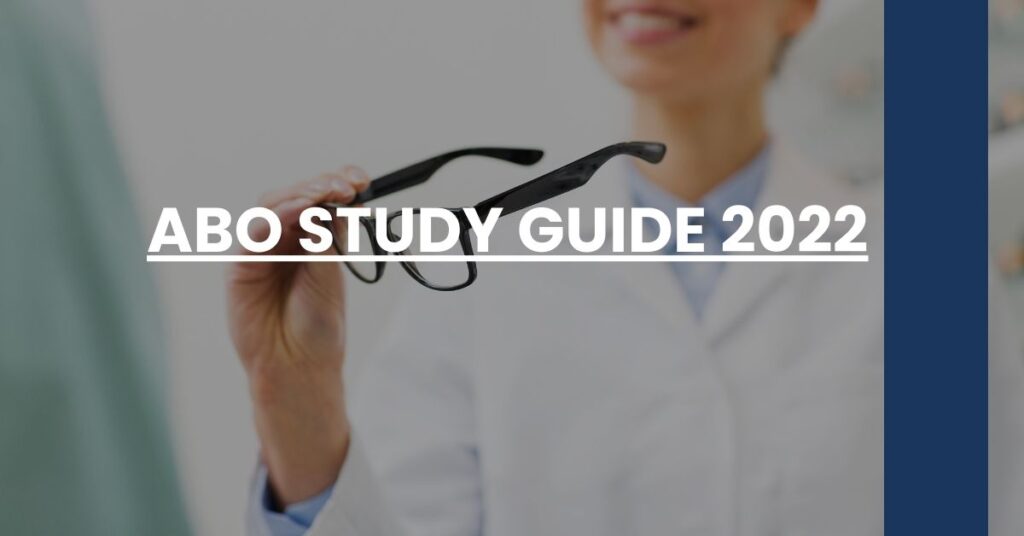Explore the ABO study guide 2022 and unlock the secrets to passing your optician exam with flying colors.
- Exam Structure Mastery: Familiarize yourself with the ABO exam’s format to optimize your study sessions.
- Essential Calculations: Gain confidence in optical formulas that are the backbone of the ABO exam.
- Product Knowledge: Enhance your understanding of ophthalmic products, crucial for exam success.
Prepare to conquer the ABO study guide 2022 and take your opticianry skills to new heights.
- Understanding the ABO Exam Structure
- Essential Optical Formulas and Calculations
- Ocular Anatomy, Physiology, and Pathology Review
- Ophthalmic Products Knowledge
- Instrumentation Expertise
- Mastering Dispensing Procedures
- Laws, Regulations, and Standards in Opticianry
- Effective Study Strategies and Tips
- Review Materials and Resources
- Conclusion: Next Steps After ABO Certification
Understanding the ABO Exam Structure
The Blueprint to Conquering Your ABO Certification
Knowing the layout of the battlefield is half the victory. Similarly, understanding the structure of the ABO (American Board of Opticianry) exam is crucial to devising a winning study strategy. As you embark on your journey to ABO certification, it’s essential to familiarize yourself with what awaits within the examination room.
The ABO exam is structured to assess four key areas:
- Ocular Anatomy: This covers the extensive territory of the human eye, its mechanics, and the intricate web of physiology that keeps it operating seamlessly.
- Ophthalmic Products: From lens materials to the most recent advancements in coatings, you’ll need to be proficient in discussing and recommending these technologies.
- Instrumentation: Precision tools and devices are integral to the opticianry trade, and a clear understanding of their operation and application will be tested.
- Dispensing Procedures: The art and science of fitting, adjusting, and advising patients on eyewear is where your study meets practice.
Each section is interwoven to create a composite image of your skills and knowledge.
What to Expect on Test Day
On the day of your ABO exam, you’ll face a 125-question test conducted over two hours. The exam encompasses ocular anatomy (25%), ophthalmic products, instrumentation, and dispensing procedures – all aligned to probe your expertise in opticianry. You’re expected to exhibit competence in optical principles, lens analysis, multifocal designs, and a grasp over the relevant laws and regulations governing your practice. For a closer look into the ABO exam format, consider exploring resources like the ABO Basic Exam overview.
Tailoring Your Study Plan
To conquer the ABO test, you’ll need more than a passing acquaintance with the subject matter. Here’s how you might structure your preparation:
- Begin with a deep dive into ocular anatomy. This foundation will inform your understanding of the subsequent sections.
- Progress to mastering ophthalmic products, where memorization of lens specifications and treatments becomes pivotal.
- Move on to instrumentation, familiarizing yourself with the tools of the trade.
- Culminate with dispensing procedures, where you translate knowledge into practical skill.
Understanding the ABO exam’s structure is your groundwork to crafting a study regimen that is both methodical and focused.
Essential Optical Formulas and Calculations
Cracking the Numerical Code
Optical formulas and calculations stand as the pillars of precision in opticianry. Sharpening your math skills is not negotiable. To guide you through this numerical labyrinth, here are some cornerstone concepts:
- Prentice’s Rule: Mastering this formula for calculating prism in lenses is a must. It’s the skeleton key to deciphering myriad prescription queries.
- Prism Calculations: Whether it’s understanding how to measure the displacing effect of a lens or calculating the prism needed to correct a patient’s vision, familiarity with these calculations is paramount.
- Focal Length: Comprehending how to determine the strength of a lens to focus light is another non-negotiable skill.
- Transposing Prescriptions: This is the art of changing a prescription from one form to another without altering its effect.
To dive deeper into the essential optical formulations that will serve as your guiding stars, look into authoritative discussions like those shared on optician forums.
Ocular Anatomy, Physiology, and Pathology Review
The Eyes Have It: A Comprehensive Look Inside
Consider this: the eyes are among the most complex organs in the human body. Understanding the structure, function, and potential illnesses that can affect the eyes not only enhances your professional acumen but also bolsters the trust patients place in your care.
Covering topics like:
- The Cornea and Lens: Realize how these front-facing eye structures bend light and facilitate vision.
- Retina and Optic Nerve: Gain insights into how signals are sent from the eye to the brain.
- Common Eye Diseases: Glaucoma, cataracts, and macular degeneration are just a few conditions you should be well-versed in.
Your proficiency in ocular anatomy, physiology, and pathology adds dimensions to your role as an optician, extending beyond mere eyewear fitting to encompass an empathetic advisor on ocular health. To enhance your understanding in this field, scholarly articles and research on the incidence of ocular pathology can prove invaluable.
Ophthalmic Products Knowledge
The Material World of Opticianry
The array of ophthalmic products may seem dizzying, but your ease with the subject matter can be a game-changer in delivering optimal care.
Key product knowledge includes:
- Lens Materials: Stay up-to-date on the ever-evolving materials—from polycarbonate to high-index plastics.
- Coatings and Treatments: Understand the benefits of anti-reflective, scratch-resistant, and blue-light filtering options.
- Frame Materials: Titanium, acrylic, and more – each material brings a unique blend of style, weight, and durability.
Your command over the ophthalmic products arena will be evident and essential when advising patients on the best solutions for their lifestyle and vision needs. For further insight, the PECAA portal provides a treasure trove of information for opticians wishing to stay at the forefront of product knowledge.
Instrumentation Expertise
Tools of the Trade: Beyond Wielding Instruments
In the hands of a skilled optician, diagnostic and dispensing instruments serve as extensions of your expertise. Your adeptness with these tools underpins the precision and excellence of your service.
- Lensometers: Use this device to verify the correct prescription in a pair of glasses.
- Pupillometers: A tool essential for determining the pupillary distance and ensuring a perfect lens fit.
- Tonometers: Utilize these to gauge intraocular pressure, an invaluable parameter in glaucoma detection.
Ensuring the effective operation and upkeep of these instruments is not just about maintenance—it’s about guaranteeing that every client interaction and every lens dispensed meets the highest standards of quality.
Mastering Dispensing Procedures
The Art of Personalization in Eyewear
Dispensing is where your technical knowledge encounters the personal touch you provide each patient. It’s the fine art of aligning aesthetics, comfort, and impeccable vision.
- Precision in Measurements: Ensure that each eyewear is customized to the wearer’s unique specifications by mastering the use of tools like the pupillometer and millimeter ruler.
- Adjustment Techniques: Develop a deft touch for bending frames without causing strain, modifying nose pads for a seamless fit, and finessing temple lengths for comfort.
- Patient Education: Engage your patients by walking them through maintenance tips, the importance of regular eye check-ups, and the proper use of their eyewear.
When you exhibit expertise in dispensing procedures, you not only provide clients with flawless eyewear, but you also instill a level of trust that’s unmatched. Your proficiency in this area can define your reputation as a specialist well-versed in an ABO study guide 2022.
Developing a Customer-Centric Approach
Remember, the essence of dispensing lies not just in the fit of the lens but also in the experience you curate for each client.
- Active Listening: Attune yourself to the subtle cues and preferences your patients express.
- Educational Insight: Frame your guidance in a way that empowers your clients to make informed choices.
With this customer-centric approach, dispensing becomes more than a transaction—it’s an opportunity to foster long-term relationships and ensure the wellbeing of those you serve.
Laws, Regulations, and Standards in Opticianry
Navigating the Legal Landscape
Staying current with laws, regulations, and ethical standards is non-negotiable. This knowledge ensures that your practice isn’t just about precision, but also about integrity.
- State-specific Legislation: Be aware of the state-by-state variations in opticianry requirements and the intricacies of national standards.
- HIPAA Compliance: Maintain the highest standards of privacy and confidentiality to build unwavering trust with your patients.
By understanding these guidelines, you protect not only your patients but also the reputation and operational excellence of your practice. The ABO study guide 2022 will outline these critical aspects, acting as your roadmap through the complexities of legal compliance.
Ethical Considerations in Practice
Your ethical compass guides every decision, from advising on the best lens materials to navigating complex patient scenarios.
- Conflict of Interest: Acknowledge and navigate potential conflicts with honesty and transparency.
- Continued Education: Commit to lifelong learning, ensuring that your practice is always at the cutting edge of opticianry.
By upholding these standards, you embody the professional ethos that the ABO certification demands and that your patients deserve.
Effective Study Strategies and Tips
Unlocking Your Learning Potential
Everyone’s learning journey is unique. To find what works best for you, consider embracing a mix of study strategies.
- Craft a Study Schedule: Dedicate time slots for focused study, allowing for regular breaks to rejuvenate your mind.
- Employ Active Learning: Don’t just read—write, draw, and discuss key concepts to reinforce retention.
- Mock Exams: Testing yourself under exam-like conditions can acclimatize you to the pressure and pacing of the actual ABO exam.
Incorporate these methods as you delve into the ABO study guide 2022, and the once daunting material will start to feel more manageable.
Leveraging the Right Resources
Your choice of study materials is as crucial as your study habits. Select resources such as comprehensive course packages and workbooks that resonate with your learning style.
- Multiple Modalities: Combine reading with audio and visual aids for a well-rounded study experience.
- Study Groups: Collaborate with peers to challenge your understanding and gain new perspectives.
With these strategies, you can transform the vast sea of information into islands of knowledge that you navigate with confidence.
Review Materials and Resources
The Toolkit for Success
Complement your study efforts with a carefully curated selection of review materials and learning tools.
- Textbooks and Manuals: Ensure these are up-to-date and aligned with the latest ABO standards.
- Flashcards: Utilize these for quick recall of essential terms and concepts.
- Online Platforms: Engage with interactive courses and online forums for real-time learning and feedback.
For a comprehensive guide that specifically targets the ABO exam, resources like ABO exam prep systems can offer structured learning paths perfectly tailored to your certification journey.
Conclusion: Next Steps After ABO Certification
Charting Your Professional Journey
Congratulations! You’ve navigated the ABO study guide 2022 and emerged successful. The ABO certification is a validation of your dedication and skill—an accolade that opens new doors in the field of opticianry.
After certification, consider the spectrum of opportunities before you:
- Specialize Further: Explore niches like contact lens fitting or pediatric opticianry to distinguish yourself.
- Pursue Leadership: Use your expertise to take on supervisory roles or even start your own practice.
The road post-certification is threaded with potential for growth, adventures in learning, and the chance to shape the future of eye care. Embrace it wholeheartedly, knowing that you have forged a foundation strong enough to support whichever path you choose to tread.

